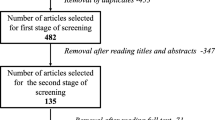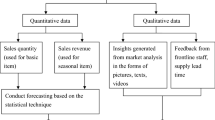Abstract
We propose the new Top-Dog-Index, a measure for the branch-dependent historic deviation of the supply data of apparel sizes from the sales data of a fashion discounter. Our approach individually measures for each branch the scarcest and the amplest sizes, aggregated over all products. This measurement can iteratively be used to adapt the size distributions in the pre-pack orders for the future. A real-world blind study shows the potential of this distribution free heuristic optimization approach: The gross yield measured in percent of gross value was almost one percentage point higher in the test-group branches than in the control-group branches.












Similar content being viewed by others
Notes
The assumption of a maximal sales period of six months is a management decision ensuring a frequent assortment change, i.e., whenever a product is not sold out within this time frame, prices are cut down in advance.
References
Aksoy, A., Ozturk, N., & Sucky, E. (2012). A decision support system for demand forecasting in the clothing industry. International Journal of Clothing Science and Technology, 24(4), 221–236.
Bitran, G. R., Caldentey, R., & Mondschein, S. V. (1998). Coordinating clearance markdown sales of seasonal products in retails chains. Operations Research, 46(5), 609–624.
Caro, F., & Gallien, J. (2010). Inventory management of a fast-fashion retail network. Operations Research, 58(2), 257–273.
Chan, L. M. A., Max Shen, Z. J., Simchi-Levi, D., & Swann, J. L. (2006). Coordination of pricing and inventory decisions: A survey and classification. In D. Simchi-Levi, S. D. Wu, Z. J. Max Shen (Eds.), Handbook of quantitative supply chain analysis: Modeling in the e-business era, Chap. 14 (pp. 335–392). Dordrecht: Kluwer.
Elmaghraby, W., & Keskinocak, P. (2003). Dynamic pricing in the presence of inventory considerations: Research overview, current practices, and future directions. Management Science, 49(10), 1287–1309.
Fisher, T. (2013). On simple representations of stopping times and stopping time sigma-algebras. Statistics & Probability Letters, 83(1), 345–349.
Garro, A. (2011). A new product forecasting and distribution optimization: A case study at Zara PhD thesis, MIT, Massachusetts, USA, 194 pp.
Kießling, M., Kurz, S., & Rambau, J. (2012). The integrated size and price optimization problem. Numerical Algebra, Control and Optimization, 2(4), 669–693.
Kök, A. G., & Fisher, M. L. (2007). Demand estimation and assortment optimization under substitution: Methodology and application. Operations Research, 55(6), 1001–1021.
Mahajan, S., & van Ryzin, G. (2001). Stocking retail assortments under dynamic consumer substitution. Operations Research, 49(3), 334–351.
Mostard, J., Teunterb, R., & de Kostera, R. (2011). Forecasting demand for single-period products: A case study in the apparel industry. European Journal of Operational Research, 211(1), 139–147.
Ni, Y., & Fan, F. (2011). A two-stage dynamic sales forecasting model for the fashion retail. Expert Systems with Applications, 38(3), 1529–1536.
Quante, R., Meyr, H., & Fleischmann, M. (2008). Revenue management and demand fulfillment: Matching applications, models, and software. International Journal of Services Sciences, 1(2), 127–147.
van Ryzin, G., & Mahajan, S. (1999). On the relationship between inventory costs and variety benefits in retail assortments. Management Science, 45(11), 1496–1509.
Vulcano, G., van Ryzin, G., & Ratcliff, R. (2012). Estimating primary demand for substitutable products from sales transaction data. Operations Research, 38(6), 7373–7379.
Yu, Y., Choi, T.-M., & Hui, C.-L. (2011). An intelligent fast sales forecasting model for fashion products. Expert Systems with Applications, 60(2), 313–334.
Zhou, J., & Xu, Q. (2008). Analysis of system dynamics model in garment supply chain. Journal of Textile Research, 29(12), 122–125.
Acknowledgments
This research was supported by the Bayerische Forschungsstiftung, Project DISPO—A Decision Support for the Integrated Size and Price Optimization. The authors thank Lutz Schade and Tobias Metze as well as an anonymous referee for valuable comments on an earlier version of the manuscript.
Author information
Authors and Affiliations
Corresponding author
Rights and permissions
About this article
Cite this article
Kurz, S., Rambau, J., Schlüchtermann, J. et al. The Top-Dog Index: a new measurement for the demand consistency of the size distribution in pre-pack orders for a fashion discounter with many small branches. Ann Oper Res 229, 541–563 (2015). https://doi.org/10.1007/s10479-014-1746-8
Published:
Issue Date:
DOI: https://doi.org/10.1007/s10479-014-1746-8
Keywords
- Revenue management
- Size optimization
- Demand forecasting
- Top-Dog-Index
- Field study
- Parallel blind testing




